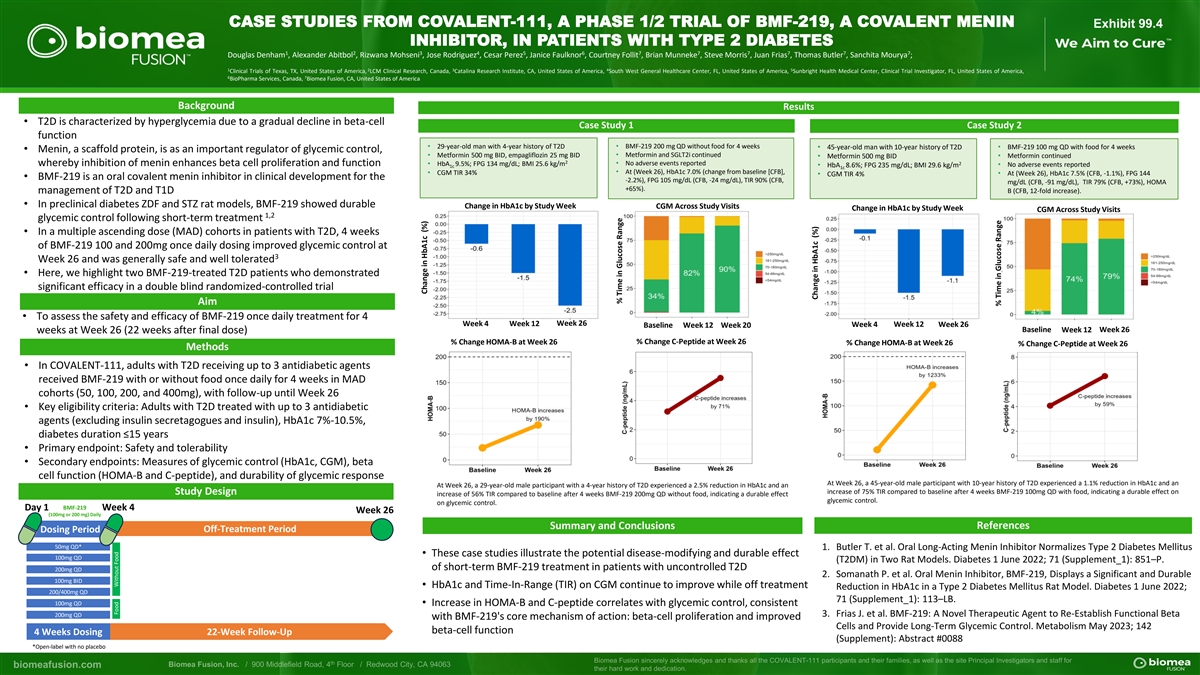
CASE STUDIES FROM COVALENT-111, A PHASE 1/2 TRIAL OF BMF-219, A COVALENT MENIN Exhibit 99.4 INHIBITOR, IN PATIENTS WITH TYPE 2 DIABETES 1 2 3 4 5 6 7 7 7 7 7 7 Douglas Denham , Alexander Abitbol , Rizwana Mohseni , Jose Rodriguez , Cesar Perez , Janice Faulknor , Courtney Follit , Brian Munneke , Steve Morris , Juan Frias , Thomas Butler , Sanchita Mourya ; 1 2 3 4 5 Clinical Trials of Texas, TX, United States of America, LCM Clinical Research, Canada, Catalina Research Institute, CA, United States of America, South West General Healthcare Center, FL, United States of America, Sunbright Health Medical Center, Clinical Trial Investigator, FL, United States of America, 6 7 BioPharma Services, Canada, Biomea Fusion, CA, United States of America Background Results • T2D is characterized by hyperglycemia due to a gradual decline in beta-cell Case Study 1 Case Study 2 function • 29-year-old man with 4-year history of T2D• BMF-219 200 mg QD without food for 4 weeks• BMF-219 100 mg QD with food for 4 weeks • 45-year-old man with 10-year history of T2D • Menin, a scaffold protein, is as an important regulator of glycemic control, • Metformin 500 mg BID, empagliflozin 25 mg BID• Metformin and SGLT2i continued • Metformin 500 mg BID• Metformin continued 2 • No adverse events reported 2 whereby inhibition of menin enhances beta cell proliferation and function• HbA 9.5%; FPG 134 mg/dL; BMI 25.6 kg/m• No adverse events reported 1c • HbA 8.6%; FPG 235 mg/dL; BMI 29.6 kg/m 1c • At (Week 26), HbA1c 7.0% (change from baseline [CFB], • CGM TIR 34% • CGM TIR 4%• At (Week 26), HbA1c 7.5% (CFB, -1.1%), FPG 144 • BMF-219 is an oral covalent menin inhibitor in clinical development for the -2.2%), FPG 105 mg/dL (CFB, -24 mg/dL), TIR 90% (CFB, mg/dL (CFB, -91 mg/dL), TIR 79% (CFB, +73%), HOMA +65%). B (CFB, 12-fold increase). management of T2D and T1D • In preclinical diabetes ZDF and STZ rat models, BMF-219 showed durable Change in HbA1c by Study Week CGM Across Study Visits Change in HbA1c by Study Week CGM Across Study Visits 1,2 glycemic control following short-term treatment • In a multiple ascending dose (MAD) cohorts in patients with T2D, 4 weeks of BMF-219 100 and 200mg once daily dosing improved glycemic control at 3 Week 26 and was generally safe and well tolerated • Here, we highlight two BMF-219-treated T2D patients who demonstrated significant efficacy in a double blind randomized-controlled trial Aim • To assess the safety and efficacy of BMF-219 once daily treatment for 4 Week 4 Week 12 Week 26 Week 4 Week 12 Week 26 Baseline Week 12 Week 20 Baseline Week 12 Week 26 weeks at Week 26 (22 weeks after final dose) % Change HOMA-B at Week 26 % Change C-Peptide at Week 26 % Change HOMA-B at Week 26 % Change C-Peptide at Week 26 Methods • In COVALENT-111, adults with T2D receiving up to 3 antidiabetic agents received BMF-219 with or without food once daily for 4 weeks in MAD cohorts (50, 100, 200, and 400mg), with follow-up until Week 26 • Key eligibility criteria: Adults with T2D treated with up to 3 antidiabetic agents (excluding insulin secretagogues and insulin), HbA1c 7%-10.5%, diabetes duration ≤15 years • Primary endpoint: Safety and tolerability • Secondary endpoints: Measures of glycemic control (HbA1c, CGM), beta cell function (HOMA-B and C-peptide), and durability of glycemic response At Week 26, a 45-year-old male participant with 10-year history of T2D experienced a 1.1% reduction in HbA1c and an At Week 26, a 29-year-old male participant with a 4-year history of T2D experienced a 2.5% reduction in HbA1c and an increase of 75% TIR compared to baseline after 4 weeks BMF-219 100mg QD with food, indicating a durable effect on Study Design increase of 56% TIR compared to baseline after 4 weeks BMF-219 200mg QD without food, indicating a durable effect glycemic control. on glycemic control. BMF-219 Day 1 Week 4 Week 26 (100mg or 200 mg) Daily Summary and Conclusions References Dosing Period Off-Treatment Period 50mg QD* 1. Butler T. et al. Oral Long-Acting Menin Inhibitor Normalizes Type 2 Diabetes Mellitus • These case studies illustrate the potential disease-modifying and durable effect 100mg QD (T2DM) in Two Rat Models. Diabetes 1 June 2022; 71 (Supplement_1): 851–P. of short-term BMF-219 treatment in patients with uncontrolled T2D 200mg QD 2. Somanath P. et al. Oral Menin Inhibitor, BMF-219, Displays a Significant and Durable 100mg BID • HbA1c and Time-In-Range (TIR) on CGM continue to improve while off treatment Reduction in HbA1c in a Type 2 Diabetes Mellitus Rat Model. Diabetes 1 June 2022; 200/400mg QD 71 (Supplement_1): 113–LB. 100mg QD • Increase in HOMA-B and C-peptide correlates with glycemic control, consistent 200mg QD 3. Frias J. et al. BMF-219: A Novel Therapeutic Agent to Re-Establish Functional Beta with BMF-219's core mechanism of action: beta-cell proliferation and improved Cells and Provide Long-Term Glycemic Control. Metabolism May 2023; 142 beta-cell function 4 Weeks Dosing 22-Week Follow-Up (Supplement): Abstract #0088 *Open-label with no placebo Food Without Food Change in HbA1c (%) % Time in Glucose Range Change in HbA1c (%) % Time in Glucose Range
